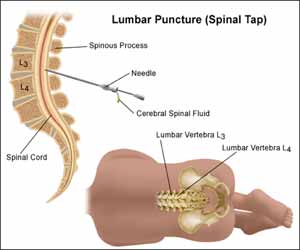- Home
- Editorial
- News
- Practice Guidelines
- Anesthesiology Guidelines
- Cancer Guidelines
- Cardiac Sciences Guidelines
- Critical Care Guidelines
- Dentistry Guidelines
- Dermatology Guidelines
- Diabetes and Endo Guidelines
- Diagnostics Guidelines
- ENT Guidelines
- Featured Practice Guidelines
- Gastroenterology Guidelines
- Geriatrics Guidelines
- Medicine Guidelines
- Nephrology Guidelines
- Neurosciences Guidelines
- Obs and Gynae Guidelines
- Ophthalmology Guidelines
- Orthopaedics Guidelines
- Paediatrics Guidelines
- Psychiatry Guidelines
- Pulmonology Guidelines
- Radiology Guidelines
- Surgery Guidelines
- Urology Guidelines
Use of Ultrasound Guidance for Adult Lumbar Puncture: Position Statement of Society of Hospital Medicine

Society of Hospital Medicine (SHM) has published a position statement on Use of Ultrasound Guidance for Adult Lumbar Puncture. SHM has presented recommendations with supporting evidence for the clinical outcomes, techniques, and training for using ultrasound guidance for LP. SHM POCUS Task Force has released several recommendations among these are the recommendations that ultrasound “should be used” for mapping the lumbar spine and selecting an appropriate puncture site in order to reduce insertion attempts, reduce needle redirections, and increase overall procedural success. The guidance has been published in the Journal of Hospital Medicine.
Main recommendations are-
- When ultrasound equipment is available, along with providers who are appropriately trained to use it, we recommend that ultrasound guidance should be used for site selection of lumbar puncture to reduce the number of needle insertion attempts and needle redirections and increase the overall procedure success rates, especially in patients who are obese or have difficult-to-palpate landmarks.
- We recommend that ultrasound should be used to more accurately identify the lumbar spine level than physical examination in both obese and nonobese patients.
- We suggest using ultrasound for selecting and marking a needle insertion site just before performing a lumbar puncture in either a lateral decubitus or sitting position. The patient should remain in the same position after marking the needle insertion site.
- We recommend that a low-frequency transducer, preferably a curvilinear array transducer, should be used to evaluate the lumbar spine and mark a needle insertion site. A high-frequency linear array transducer may be used in nonobese patients.
- We recommend that ultrasound should be used to map the lumbar spine, starting at the level of the sacrum and sliding the transducer cephalad, sequentially identifying the lumbar spine interspaces.
- We recommend that ultrasound should be used in a transverse plane to mark the midline of the lumbar spine and in a longitudinal plane to mark the interspinous spaces. The intersection of these two lines marks the needle insertion site.
- We recommend that ultrasound should be used during a preprocedural evaluation to measure the distance from the skin surface to the ligamentum flavum from a longitudinal paramedian view to estimate the needle insertion depth and ensure that a spinal needle of adequate length is used.
- We recommend that novices should undergo simulation-based training, where available, before attempting ultrasound-guided lumbar puncture on actual patients.
- We recommend that training in ultrasound-guided lumbar puncture should be adapted based on prior ultrasound experience, as learning curves will vary.
- We recommend that novice provider should be supervised when performing ultrasound-guided lumbar puncture before performing the procedure independently on patients.
For further reference log on to :
guidedJournal of Hospital MedicineLumbar PunctureSociety of Hospital MedicineUltrasoundUltrasound Guidance
Source : By inputs from Journal of Hospital MedicineNext Story
NO DATA FOUND

Disclaimer: This site is primarily intended for healthcare professionals. Any content/information on this website does not replace the advice of medical and/or health professionals and should not be construed as medical/diagnostic advice/endorsement or prescription. Use of this site is subject to our terms of use, privacy policy, advertisement policy. © 2020 Minerva Medical Treatment Pvt Ltd